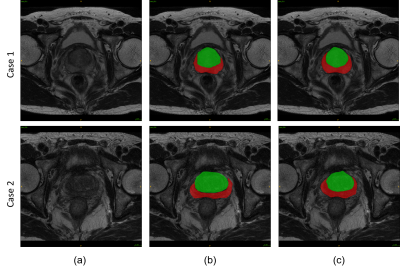4107
Few-shot Meta-learning with Adversarial Shape Prior for Zonal Prostate Segmentation on T2 Weighted MRI1The University of Hong Kong, Hong Kong, Hong Kong
Synopsis
We propose a novel gradient-based meta-learning scheme to tackle the challenges when deploying the model to a different medical center with the lack of labeled data. A pre-trained model is always suboptimal when deploying to different medical centers, where various protocols and scanners are used. Our method combines a 2D U-Net as a segmentor to generate segmentation maps and an adversarial network to learn from the shape prior in the meta-train and meta-test. Evaluation results on the public prostate MRI data and our HKU local database show that our approach outperformed the existing naive U-Net methods.
Introduction
Prostate cancer is one of the most concerning cancers in males. Recently, deep learning-based automated prostate segmentation methods are proposed to segment the prostate from MRI. Many studies focus on the whole gland segmentation, while it is necessary to obtain the zonal segmentation of different zones in the prostate for cancer diagnosis (i.e., the PIRADS v2 score). Our work investigates the automated segmentation of the central zone (CZ) and the peripheral zone (PZ) in prostate T2-weighted (T2w) images. The lack of sufficient labeled data and the domain shift between medical centers exist as two crucial challenges for deep learning-based segmentation approaches in medical-AI practice. We introduce a U-Net segmentor and a CNN discriminator using the meta-learning gradient update approach to tackle the lack of label data and multi-center problems.Methods
We propose a novel gradient-based meta-learning training scheme of the deep learning segmentation network. The model combines a 2D U-Net as a segmentor and a GAN discriminator network. The meta-learning training strategy involves the meta-train and meta-test tasks from public datasets. We treat the CZ, PZ, and whole gland as the tasks in the meta-model, while data from various centers and scanners we can randomly choose as different tasks. Generally, we take a series of 5:1 samples from training/testing tasks and update the network parameter. The CNN discriminator network in the adversarial part consists of 4 convolution layers and a fully-connect layer. The input of the adversarial network is cropped to the prostate ROI according to the ground truth label. Batch normalization is enabled in the encoding and decoding process. The training of the discriminator network also involves meta-train and meta-test tasks. A shape-related loss has been further integrated into the U-Net and discriminator network to learn from the compactness and smoothness of zonal shapes. The public dataset we are using containg 6 center data with 20 samples each. We tested the trained model on the unseen local dataset (N=20) and compared it with the conventional 2D and 3D U-Net model performance-based a larger dataset (N=100) to validate our method. The training process is implemented in tensorflow and a GPU card NVIDIA V100 with 20K iterations.Results
Our model achieved a higher Dice score (0.79, 0.87) for the central zone (CZ) and peripheral zone (PZ), respectively. Compared with the 2D U-Net results (0.78, 0.85) trained on a larger local dataset, the model combined meta-learning, and the adversarial network has shown optimal segmentation results and robustness in learning the shape smoothness and shape prior of the prostate, even in relatively fewer local data (i.e., few-shot) and public multi-center datasets.Conclusion
The gradient-based meta-learning network parameter learning procedure demonstrated in this study outperforms the conventional training process on the multi-center datasets. It presents better zonal segmentation results to combine the 2D U-Net model with a CNN discriminator network.Acknowledgements
No acknowledgement found.References
1. Finn, C., Abbeel, P. and Levine, S., 2017. Model-agnostic meta-learning for fast adaptation of deep networks. arXiv preprint arXiv:1703.03400.
2. Cao, P., Noworolski, S.M., Starobinets, O., Korn, N., Kramer, S.P., Westphalen, A.C., Leynes, A.P., Pedoia, V. and Larson, P., 2020. Development of Conditional Random Field Insert for UNet-based Zonal Prostate Segmentation on T2-Weighted MRI. arXiv preprint arXiv:2002.06330.
3. Liu, Q., Dou, Q. and Heng, P.A., 2020, October. Shape-aware Meta-learning for Generalizing Prostate MRI Segmentation to Unseen Domains. In International Conference on Medical Image Computing and Computer-Assisted Intervention (pp. 475-485). Springer, Cham.
4. Xue, Y., Xu, T., Zhang, H., Long, L.R. and Huang, X., 2018. Segan: Adversarial network with multi-scale l 1 loss for medical image segmentation. Neuroinformatics, 16(3-4), pp.383-392.
5. Kossaifi, J., Tran, L., Panagakis, Y. and Pantic, M., 2018. Gagan: Geometry-aware generative adversarial networks. In Proceedings of the IEEE conference on computer vision and pattern recognition (pp. 878-887).
Figures

